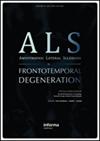Further analysis of KIFAP3 gene in ALS patients from Switzerland and Sweden
IF 2.8
4区 医学
Q2 CLINICAL NEUROLOGY
Amyotrophic Lateral Sclerosis and Frontotemporal Degeneration
Pub Date : 2017-01-31
DOI:10.1080/21678421.2017.1280509
引用次数: 4
Abstract
Abstract A series of studies suggests that susceptibility to ALS may be influenced by variants in multiple genes. While analyses of the 10% of cases of familial origin have identified more than 33 monogenic ALS-causing genetic defects, little is known about genetic factors that influence susceptibility or phenotype in sporadic ALS (SALS). We and others conducted a genome-wide association study (GWAS) in a cohort of 1014 ALS cases from Western Europe, England and the United States, and identified an intronic single nucleotide polymorphism (SNP) rs1541160 in the KIFAP3 gene that was statistically associated with improved survival. We have now completed an additional survival analysis examining the impact of the rs1541160 genotype in a cohort of 264 ALS and progressive bulbar palsy (PBP) cases. In the combined cohort of 264 patients, the CC, CT and TT genotypes for rs1541160 were detected, respectively, in 8.3% (22), 41.7% (110) and 50.0% (132). This study does not show an influence of KIFAP3 variants on survival in the studied Swiss and Swedish cohort. There was a difference in survival between the US and English patients and the patients from the Netherlands. The effect of KIFAP3 variants may be population specific, or the rs1541160 association reported previously may have been a false-positive.瑞士和瑞典ALS患者KIFAP3基因的进一步分析
摘要一系列研究表明,ALS的易感性可能受到多个基因变异的影响。虽然对10%的家族性ALS病例的分析已经确定了超过33个单基因ALS导致遗传缺陷,但对影响散发性ALS(SALS)易感性或表型的遗传因素知之甚少。我们和其他人对来自西欧、英国和美国的1014例ALS病例进行了全基因组关联研究(GWAS),并在KIFAP3基因中发现了一个内含子单核苷酸多态性(SNP)rs1541160,该多态性在统计学上与生存率的提高相关。我们现在已经完成了一项额外的生存分析,研究了rs1541160基因型在264例ALS和进行性球麻痹(PBP)病例队列中的影响。在264名患者的联合队列中,rs1541160的CC、CT和TT基因型分别为8.3%(22)、41.7%(110)和50.0%(132)。这项研究没有显示KIFAP3变体对所研究的瑞士和瑞典队列的生存率的影响。美国和英国患者与荷兰患者的生存率存在差异。KIFAP3变体的作用可能是群体特异性的,或者之前报道的rs1541160关联可能是假阳性。
本文章由计算机程序翻译,如有差异,请以英文原文为准。
求助全文
约1分钟内获得全文
求助全文
来源期刊

Amyotrophic Lateral Sclerosis and Frontotemporal Degeneration
CLINICAL NEUROLOGY-
CiteScore
5.40
自引率
10.70%
发文量
64
期刊介绍:
Amyotrophic Lateral Sclerosis and Frontotemporal Degeneration is an exciting new initiative. It represents a timely expansion of the journal Amyotrophic Lateral Sclerosis in response to the clinical, imaging pathological and genetic overlap between ALS and frontotemporal dementia. The expanded journal provides outstanding coverage of research in a wide range of issues related to motor neuron diseases, especially ALS (Lou Gehrig’s disease) and cognitive decline associated with frontotemporal degeneration. The journal also covers related disorders of the neuroaxis when relevant to these core conditions.
 求助内容:
求助内容: 应助结果提醒方式:
应助结果提醒方式:


